Expression Lines
When the facial muscles contract, the skin moves as well forming creases. Normally, these creases are temporary but as skin ages it becomes thinner and less elastic. Its ability to bounce back after being creased then declines and the repeated mechanical stress on the skin causes some of the temporary creases to become permanent wrinkles.
Functionally, the muscles of the face fall into two groups: those associated with eating (mastication); and the ones that create facial expressions. It is the later that usually produce the first permanent wrinkles. Known collectively as expression lines, or individually as crow’s feet, laughter lines, and frown lines, they appear around the eyes and mouth, and across the forehead.
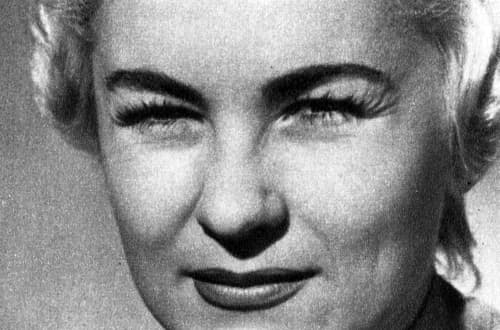
Above: Crow’s feet in the lateral corner of the eyes.

Above: Laughter lines around the mouth and eyes.

Above: Frown lines between the eyebrows.
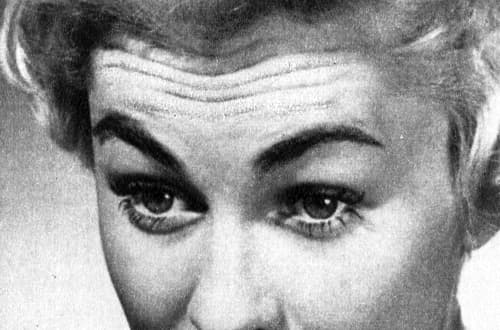
Above: Horizontal lines across the forehead.
Although expression lines are produced by the combined effect of mechanical stress and ageing, their onset and severity can be exacerbated by other factors with sun exposure and smoking being the most important.

Above: Cigarette smoking. Repeated tensing of the lips to draw smoke can also cause permanent lines to appear around the mouth, while squinting to reduce eye irritation from cigarette smoke hastens the development of crow’s feet.
Treatments
Non-invasive treatments for expression lines have not changed much over the last hundred years or so with prevention being better than cure.
Most muscles of the face are voluntary, responding to every passing emotion, and if the muscles are constantly kept at work, as in grimacing and with the odd tricks of expression, habitual with so many women, it may be understood that lines, then wrinkles will be fostered.
Even children should learn that the face should be kept in repose. The little lines around the eyes and the long “paretheses” that enclose the lips and mouth, which are excused on the ground that they are necessary to expression—“laughing wrinkles,” as they are called—in reality add years to one’s appearance …
Another wrinkle maker is the habit of lifting the eyebrows. Tiny lines grow and deepen above the eyes, and great furrows soon mar the beauty of the forehead.(Moore, 1913)
Early beauty treatments for expression lines included: ‘feeding’ the skin with skin foods; strengthening the underlying facial muscles with muscle oils; undergoing facial massages to improve the circulation of the skin and build up subcutaneous fat; and undertaking facial exercises to restore flabby muscles. I have discussed these in detail elsewhere and will not reviewing them again here.
See also: Skin Foods, Muscle Oils, Massage, Wrinkles and Double Chins and Facial Gymnastics
Added to these non-invasive beauty treatments was the use of forehead straps and tapes, the later recommended for all expression lines except for those on the forehead. Both were applied before going to bed at night or taking a rest during the day to inhibit frowning and other facial expressions from occurring while asleep. In some cases they were combined with creams or astringents but often this was not the case.
See also: Straps, Bandages and Tapes
Tapes
Tapes were largely preventative rather than a curative, so needed to be used consistently if expression lines were to be avoided. This made them an ideal commercial product and a number of companies put versions on the market, with most originating in the United States.
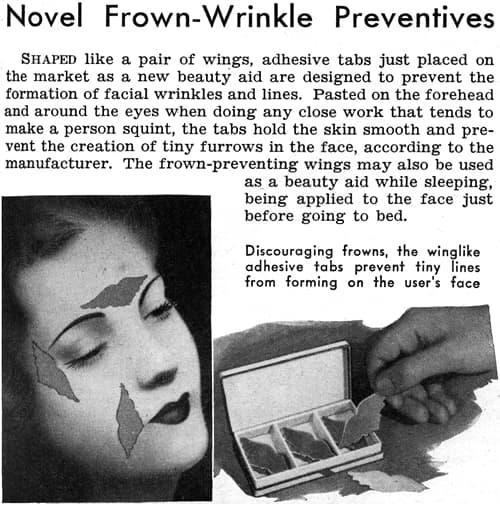
Above: 1939 Hollywood Wings.
The use of these commercial tapes has ebbed and waned over the years but similar products are still on the market today even though their effectiveness is difficult to measure. For those wishing to try taping, it was possible to avoid the expense of a commercial product by making up something at home. Perc Westmore [1904-1970], the famous Hollywood make-up artist, suggested using brown paper.
Perc Westmore, that famous Hollywood make-up expert, who works his magic on the faces of some of our greatest cinema sirens, claims that frown lines between the brows are one of the greatest of all detriments to facial loveliness.
According to Perc Westmore, however, today there’s a new wrinkle to end all frown wrinkles. A good many of the damsels out in Hollywood are employing this method. And it certainly is simplicity Itself. According to Perc, before retiring at night, all you do is cut out triangular piece of ordinary brown wrapping paper, moisten it with your tongue, and stick it between your corrugated brows. The paper won’t let you frown, and this is an excellent way of breaking you of this disastrous mannerism.(Glad, 1934)
Other suggestions
Fillers and Botox are now commonly used to reduce the appearance of expression lines but quitting cigarettes, wearing sunglasses so you don’t squint in sunlight, protecting the skin from sun damage, and controlling facial mannerisms can decrease the likelihood of developing these wrinkles in the first place. Reducing daily stresses can also help, something that was known long ago.
[I]f it is a possible thing, I would advise perfect repose of the face for a moment five or six times each day. The eyes should be closed, the muscles relaxed, and the face kept perfectly placid. These little halts in the occupations and anxieties of life retard greatly the traces which time imprints upon our faces.
(Ayer, 1892, p. 92.)
First Posted: 6th August 2021
Sources
Glad, G. Frown between brows spoils women’s beauty. (1934, May 17). The Journal-News, Rockland. Magazine page.
Moore, A. How to become beautiful. Wrinkles: Their cause and how to remove them. (1913, September 18). The Evening Times, Grand Forks, p. 5.
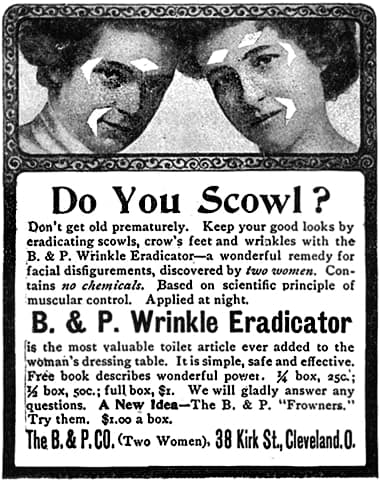
1901 B & P Frowners.
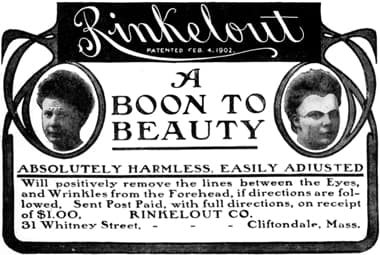
1904 Rinkelout, a forehead strap.
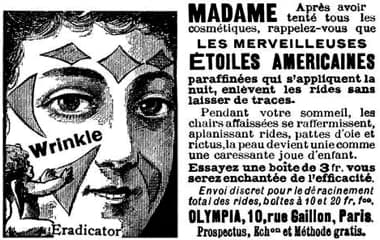
1907 Wrinkle eradicators from America (France).
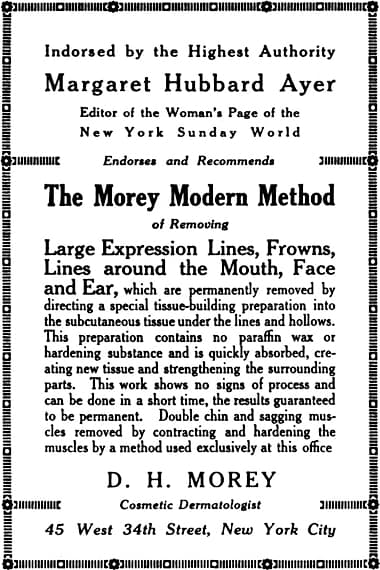
1911 Morley Modern Method.

1922 B & P Frowners.
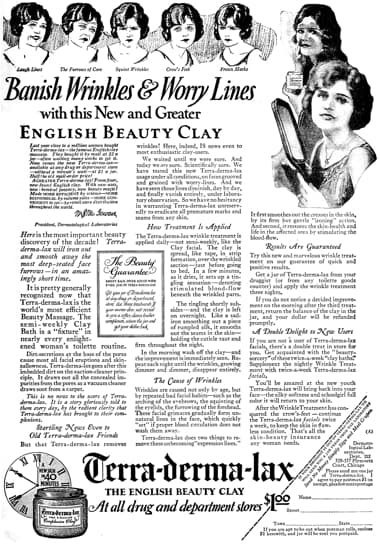
1923 Terra-derma-lax Beauty Clay.
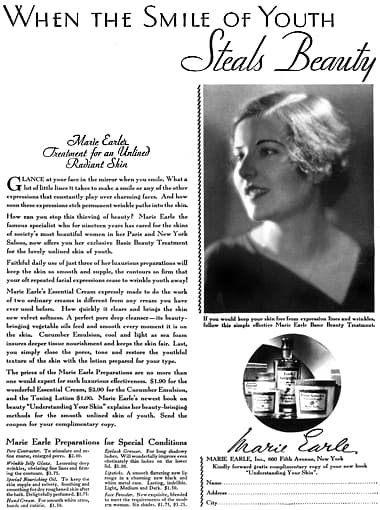
1929 Marie Earle.
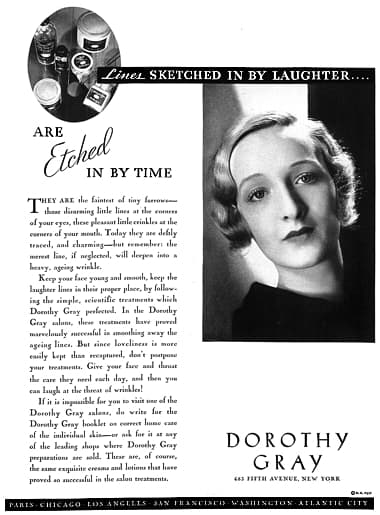
1931 Dorothy Gray.

1944 Jergens All-Purpose Cream.
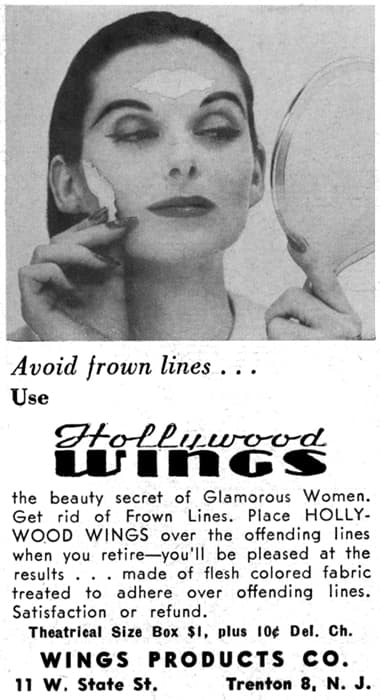
1956 Hollywood Wings.
